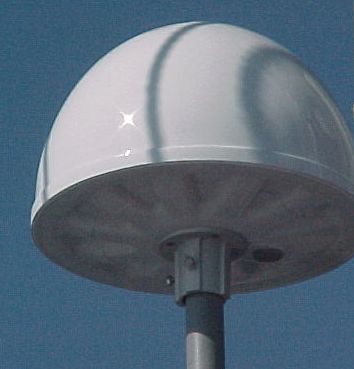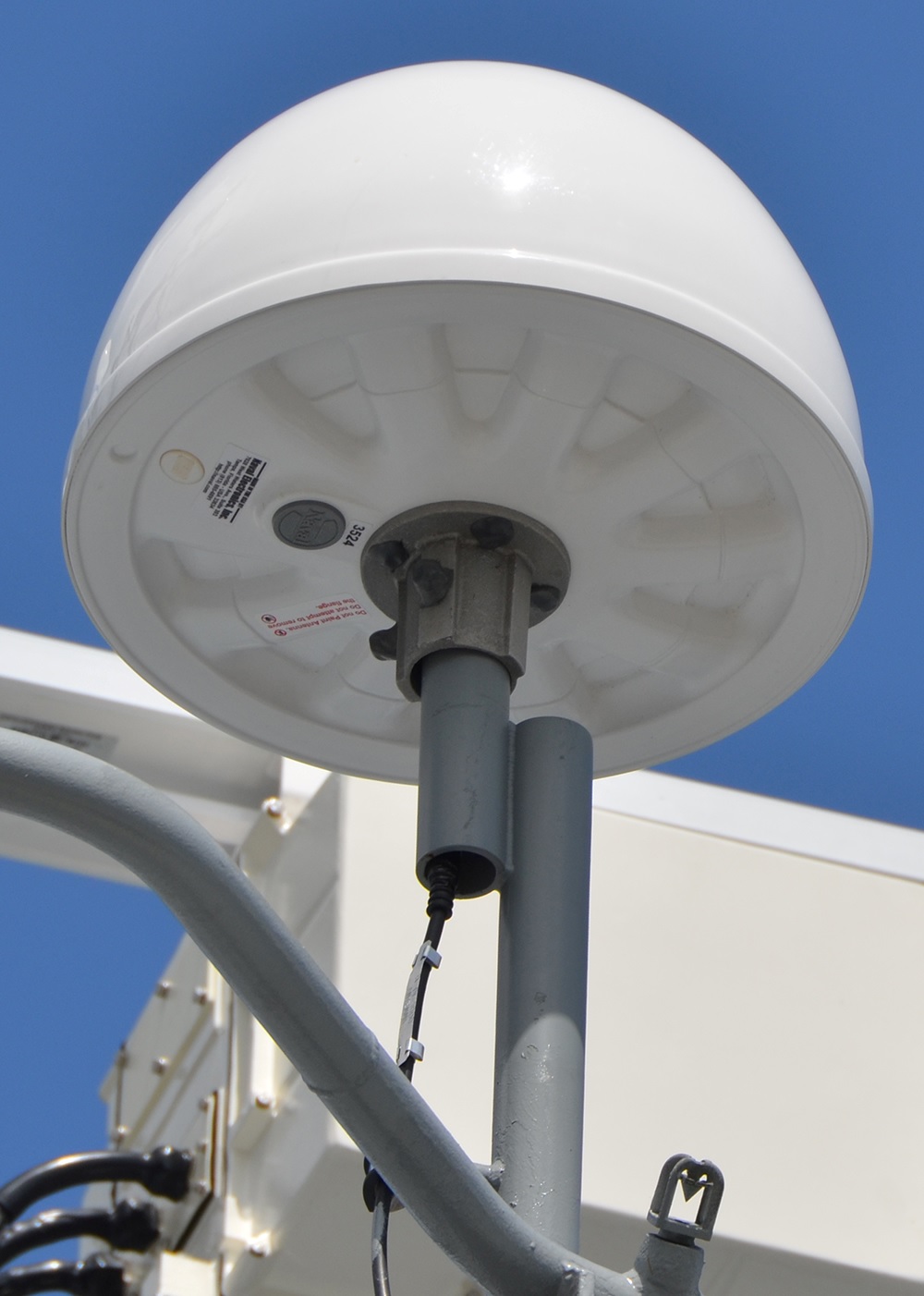

Installation Instructions for: PR-422/420 TV Antenna System.


Mount the PR-422/420 antenna high on the ship’s superstructure, clear of nearby objects. It is best if the antenna is the highest object on the ship to insure maximum possible range and Omni-directional performance. Do not mount the antenna in the beam of a radar.
Mount the antenna on a 2-inch pipe that is braced against resonant vibrations. The antenna has a short coaxial lead ending in an F connector. Make a barrel connector splice to RG-11 coaxial cable; seal the splice and connectors against moisture and water entry, using “coax-seal” or similar waterproof putty. Click here to see photos.
The usual precautions should be taken in installing the coaxial cable run. Clamp it against downloading force, so that the connection will not pull apart from the weight of the cable. Take care not to crush the cable, and avoid bends over sharp edges. The coaxial run to the headend amplifier should be less than 75 feet for best results. Any coaxial cable exposed to sunlight should be painted with non-metallic paint to prevent possible UV damage over the long term.
Bolt the headend amplifier to the bulkhead in a position convenient for service, preferably at a height corresponding to eye level for a standing person. Be sure to allow room to open the cabinet door. Connect the Cabinet Ground to Ship’s Ground.
A direct AC supply to the PRA-422/420 should have a circuit breaker or switch, or alternatively should be supplied at an AC outlet in the same room. The room should be dry, with ventilation for heat to escape. A TV set should be in sight of the headend amplifier so as to help when performing adjustments to the system. It is often convenient to use a small portable TV set for this purpose. A 20dB testpoint is provided on the PR-4900 to connect the monitor TV. Do not use any of the 4 (-8dB) ports as the levels there are too high for the monitor and will cause overloading.
The headend amplifier cabinet is supplied with feed-through F connectors. The shipyard may wish to change over from RG-11 cable to RG-6 with a pigtail splice near the cabinet; alternatively, RG-11 may be connected direct to the F connectors on the cabinet if convenient.
All coaxial cables should be tagged on each end with a non-metallic tag. The tag ID should be indicated on as-fitted drawings.
Outlets are supplied with plastic ground isolation bases. These reduce possible problems with ground loops aboard a steel ship. When making connections to these “passives”, the connector may be slightly wrench-torqued so as to insure a lasting connection throughout the life of the ship.
Water resistant F-connectors with Silicone gel sealant and O rings are available on request for RG-6 and RG-59 cables, but are not yet available for RG-11. A good quality connector should be selected (such as Amphenol), as well as a quality crimping tool. It is important for the installer to be properly skilled in making these connections. RG-11 is best for the branch runs from the headend to the first passive connection; RG-6 can be used after that, providing the runs are not excessive in length. Keep in mind that coax-cable losses affect the UHF frequencies much more than the lower VHF frequrencies so it is possible to lose the upper UHF channels altogether if the coax length and losses are excessive.
Testing:
Equipment Required:
-TDR (Time Domain Reflectometer): Tektronics or
equivalent.
-Frequency Selective Voltmeter: Sencor or equivalent
Test procedures:
TDR reading should be taken on each piece of coaxial cable where physical measurements are not possible. Lengths of all cables (to one foot accuracy) should be shown on as-fitted drawings. In addition to determining cable lengths, the TDR is able to see anomalies on the coax, and the installer should use this feature to insure that the cables and connections are true.
Perform a system test after installation is
completed,
before closing ceiling panels, etc. Inject a pilot signal at the
headend. For this purpose, a VCR generates a good signal and is
convenient
to use as a pilot signal generator, as it is a repeatable signal source
for future troubleshooting.
Experiences has shown that Shore Cable signals can vary from hour to hour and as such should not be used to inventory system levels. Most VCR units usually have a switch to allow RF output on either channel 2 or 3. Use either channel for the test; note the channel chosen on the as-fitted drawings.
Attenuators: Each attenuator is a 3 turn potentiometer and is rather delicate. Use a tuning tool or small screwdriver. Turn slowly so the end of travel stop may be felt..
Inject the VCR signal to the selected input port on the PR-422/420. While viewing the appropriate channel on the TV monitor, reduce attenuation on the amplifier until some signal degradation is noticed; then increase attenuation until this degradation is reduced. The amplifier is now adjusted for maximum gain without overdriving it. (The attenuator is situated at the amplifier input) Note the level of this Pilot. This level should be recorded and will be the reference point for all further tests.
Levels can now be taken at each coaxial output connector throughout the system, ie., at the end of each cable and at the output of each passive (splitter/tap-off/outlet). These levels must be recorded on a system block diagram or sketch. Levels can be referenced to either one microvolt or one millivolt, whichever is more convenient. There is 60 dB difference between the dBuV and dBmV figures; all drawings should indicate which reference is used. It is strongly recommended that readings be made using a logarithmic dB scale, since confusion often arises when linear voltage readings are used.
When testing is complete, the cable and connector attenuation values should correspond to the various signal level readings taken throughout the system. If a part of the system has higher than calculated attenuation, the problem must be investigated and corrected. When this happens, levels downstream from the correction point must be taken again, and recorded on the as-fitted drawings.
These final drawings are invaluable for future trouble shooting. Copies should be made for Naval Tampa, the Shipowner, and the Shipyard for future reference. Naval Tampa will archive such drawings in hard copy and on electronic media where possible.
Typical problems:
Improper terminations: These will show up as a higher-than-calculated losses; they can be frequency sensitive. They may also show as a short or open circuit if the termination is seriously corrupt.
Proper installer skills, hardware and tools are essential to a good working system. Factory Engineers are available at reasonable cost to travel world wide.
Final Adjustments:
Before commencing any testing, ensure that the system is powered up and that the amplifier is active. See the note on “Attenuators” in the Test Procedures section, above.
It is, of course, better to use testing and measuring equipment when available, such as a signal generator and a frequency-selective voltmeter.
If no measuring equipment is available: Connect the
antenna
to the PR-4000 or PR-4010. Use a TV monitor attached to the 20dB test
point
on the PR-4900.
Locate a TV station in the low VHF band and adjust
the
monitor for best picture. Locate the attenuator on the PR-422/420 and
turn
it full counter clockwise to introduce maximum attenuation of 20 dB.
Turn
the attenuator slowly clockwise while observing the monitor.
At some
point
some signal degradation may be noticed as the amplifier starts to
over-drive.
At this point the attenuation should be increased again slightly CCW to limit over driving. The amp is now at maximum gain without overdrive.
Using a Signal Generator and Frequency Selective
Voltmeter:
For the channel under adjustment, disconnect the antenna or other input
device. Feed the generator to the Antenna Input port via a DC block.
Adjust
the level of the generator for 0 dBmV and a frequency suitable for the
amplifier being adjusted. Measure the signal at the outlet with the
weakest
signal (typically at the end of the longest or highest loaded branch.
Using
the corresponding attenuator, adjust so as to obtain a level of max
0dBmV
at this outlet. Repeat the above procedure for each amplifier in the
system.

Marine TV Antenna Systems
MARINE TV ANTENNA
Systems for Navy, Merchant Shipping, Work Boats and Fine Yachts.
e-mail sales@naval.com
Naval
Electronics, Inc.
7028 West Waters Ave,
Suite 393,
Tampa, Florida
USA 33634-2292
phone (813) 885-6091
fax (813) 885-3601